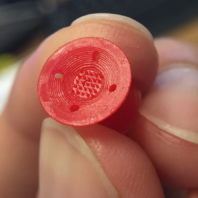June 14, 2018

By Siddharth Vodnala, intern, Voiland College of Engineering and Architecture
PULLMAN, Wash. – A Washington State University researcher has received a U.S. Department of Defense grant to develop a more convenient, less expensive and less painful way to treat serious eye diseases.
Kuen-Ren “Roland” Chen, an assistant professor in the WSU School of Mechanical and Materials Engineering, received an $264,000, 18-month exploratory grant to use 3D printing to develop a programmable microneedle array that can deliver drugs directly into the eye in a sustained manner.
The technology could be used to treat major eye diseases such as diabetic retinopathy and age-related macular degeneration.
Eye disorders and vision loss treatment cost nearly $139 billion every year, according to a report commissioned by Prevent Blindness America. But, delivering drugs into delicate eyes is challenging.
Microneedle array to deliver drugs
Eye drops often don’t work well because tears dilute them, and there is a physical barrier between most parts of the eye and blood vessels. Doctors often use laser therapy and direct eye injections, but, laser therapy has several serious side effects. Meanwhile periodic direct injections are expensive, costing nearly $2,000 a shot. This makes it important to use technology that can deliver drugs in an efficient way to minimize costs.
Microneedles, an alternative to standard hypodermic needles, are tiny, minimally invasive needles that are stacked next to each other to form a microneedle array.
While microneedle technology already exists, Chen and Ph.D. student Maher Amer are creating an innovative “locking” and “unlocking” technology for the array. They plan to use 3D printing to produce the tiny needles.
Chen’s technology, which uses a polymer gel to lock the needles in place, would allow doctors to attach the microneedle array to the eye to steadily deliver the drug for a long period and then easily detach it later.
Less invasive, less pain
The steady delivery would provide more efficient drug delivery, which would reduce costs, and would mean fewer patient hospital or clinic visits. The microneedle technology would also be less invasive, cause less pain than direct injections, and have fewer side effects, he added.
The researchers initially plan to develop their microneedle array to deliver the drug into the eye for a month, which could more effectively reduce abnormal blood vessel growth than a single direct shot.
Chen’s technology will also save money by reducing the amount of the drug that is required for treatment.
The researchers are currently developing the mold required for manufacturing the microneedles and testing its locking mechanism.